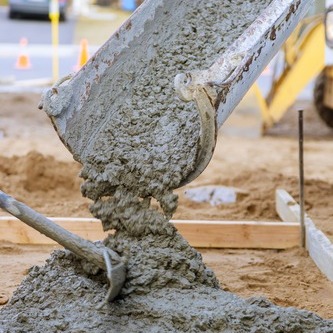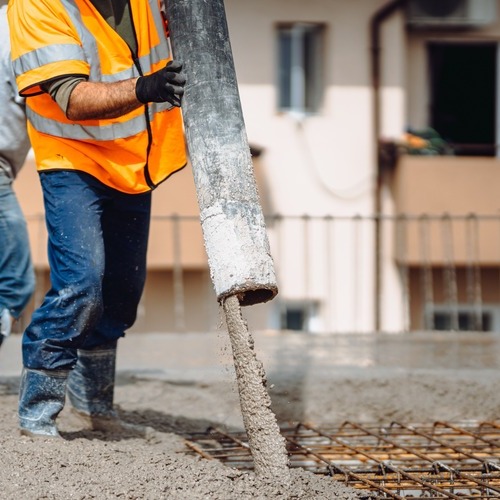
Concrete pouring process
Today, we can buy bags of concrete at the home improvement stores and handle our own small concrete jobs, like securing fence posts. But many years ago, and still, today, when it comes to large areas, like for a home or any type of structure, you need professionals that know how to pour concrete. In the construction industry, concrete pouring is done from trucks that have the concrete mixture in a drum.
That drum is constantly turning to keep the concrete from hardening until the area is ready for the concrete pouring to take place. A team of people will be ‘at the ready’ with tools to spread the wet mixture before it sets in place. For somebody having a home built, they may choose to be there and ‘autograph’ the wet cement, along with the date.
What are the steps in pouring concrete?
The concrete pouring installation process is easier than you may think, even if you haven’t ever done anything like that before, with these 6 steps:
1. PREP THE GROUND
First, the ground must be prepared before the concrete pouring can be done. How is ground prepped for concrete pouring? By removing any material or objects that can cause interference with the concrete pouring procedure. This includes shrubs, grass, old concrete, rocks, trash, trees, etc. There must be nothing but raw earth in the area being serviced.
2. BASE AND LEVEL
The area is then dug out for the concrete pouring, and for the surface to be able to drain, if isn’t sandy soil, another layer needs to be installed. What do you put down before pouring concrete? A gravel layer is poured and spread out to create a base. Then forms are built at a marginal height and nailed to a stake. The stake is tapped to reach the desired height so that a perfectly level board is in place.
3. STEEL BAR STRENGTH
Before the concrete pouring can be done, reinforcement is installed for added strength and crack resistance, using a half-inch Rebar, (a steel bar).
4. CONCRETE TRUCK PREPARATION
An inspection and review of the area are done prior to the concrete truck’s arrival for the concrete pouring to take place. This is done to avoid any mistakes, like making sure the forms are in place, level and sturdy.
5. POUR, SPREAD, FLATTEN
As the concrete pouring is happening, it will come out of the truck-mounted drum as the driver tilts the drum in slumps that are 5 to 6 inches high. At this point, the concrete mix can be moved by the crew using assorted tools to push and pull the substance to meet the leveling form’s highest point, leveling as they work.
6. SMOOTHING
As the crew smooths the concrete pouring, the slab will “bleed” water which will evaporate and vanish, allowing the concrete to harden. If the weather is hot, the entire concrete pouring process needs to be quick so that it doesn’t harden unevenly and lumpy.
How deep do they dig for a concrete slab?
The slab area is evacuated of dirt up a depth of approximately 7 inches. This allows for a three-inch gravel base and a four-inch layer of concrete pouring.
How long does it take to pour concrete?
For the actual concrete pouring action, it will depend on the size of the area. For a standard residential concrete slab, approximately an hour to two hours is standard, provided there is a sufficient crew and no problems. A large industrial concrete slab can take days, again, depending on the size of the area.
How long does it take for poured concrete to set?
It will “set” to full strength within twenty-eight days. By the 7th day, the concrete is 70% cured and considered to be full strength. Within 48 hours of the concrete pouring, it is considered “set”. However, it will never become fully cured. Once the concrete pouring is done, the concrete will continually harden – forever.
Can you pour concrete directly on dirt?
The short answer is yes. The long answer is yes with a few “buts” to follow. A good base is a good foundation for anything, especially for concrete pouring. Any flaws in the surface that will be covered will have a direct impact on the finished quality. Before you proceed with concrete pouring directly onto raw dirt, here are a few tips:
- Frame: Without a frame, your concrete pouring is going to spread out in all shapes and sizes, it won’t be level.
- Base: The base thickness will depend on the project. A driveway should have a base minimum of 10 inches, a sidewalk should have a minimum 6-inch base.
- Water: Extremely dry dirt isn’t going to compact like moist dirt, but extremely wet dirt isn’t going to compact either. It needs to be at a ‘happy medium’ for successful concrete pouring results.
- Compact: Once the dirt and soil are prepped, they should be compacted to form that solid base we’ve mentioned. Remember, concrete pouring will be more successful with a well compacted, clean base.

In Closing
Before you begin your concrete pouring project, take the steps to prep the area. If you’re going to spend the money and time of doing your own concrete pouring, doing it right will give you the most bang for your buck.
Give eSquared Asphalt Maintenance a call at 254-716-8685 for Concrete Pouring in Waco and Temple, TX.
